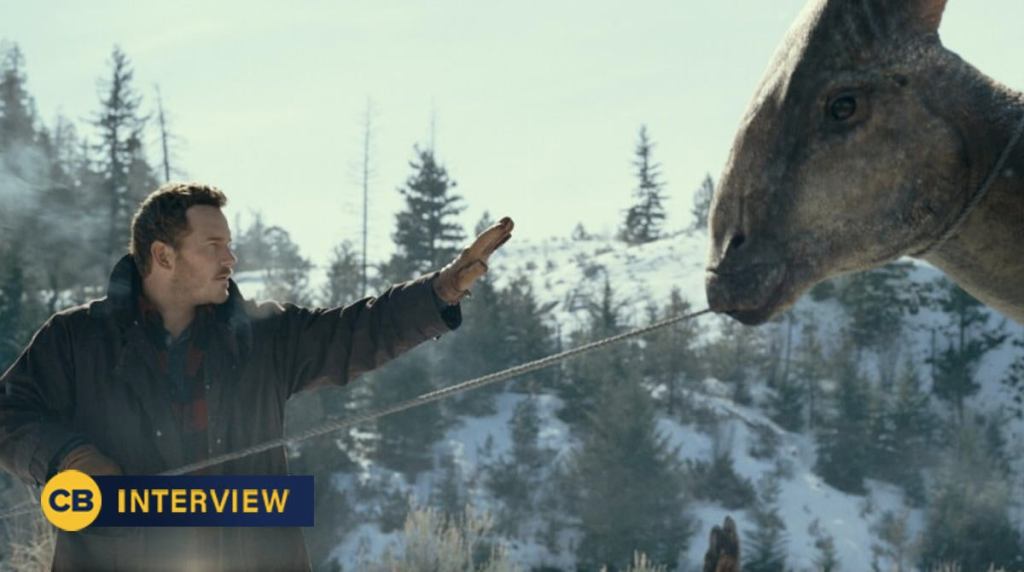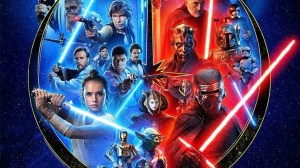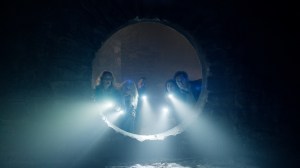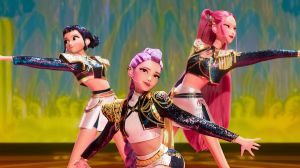For the better part of 30 years, when audiences think of the Jurassic Park and Jurassic World franchises, we think about the ways in which our heroes have faced off against prehistoric creations, often within the confines of islands on which the resorts have been built. With Jurassic World Dominion, however, director Colin Trevorrow makes good on the tease of the previous film and unleashes the compelling creatures into all-new environments, a narrative reveal that brings with it a lot of excitement, but also requires a lot of innovation, with visual effects supervisor David Vickery and the team at ILM being tasked with completing the challenge. Jurassic World Dominion is out now on 4K Ultra HD, Blu-ray, DVD, and Digital HD.
Videos by ComicBook.com
From Jurassic World architect and director Colin Trevorrow, Dominion takes place four years after Isla Nublar has been destroyed. Dinosaurs now live — and hunt — alongside humans all over the world. This fragile balance will reshape the future and determine, once and for all, whether human beings are to remain the apex predators on a planet they now share with history’s most fearsome creatures.
ComicBook.com caught up with Vickery to talk new challenges for the franchise, Easter eggs, and fresh environments.

ComicBook.com: You previously worked on Jurassic World: Fallen Kingdom, so you’re not completely new to Jurassic World. What was the big difference shifting from Fallen Kingdom to Dominion? Was there much of a shift at all in your approach? Is it just that you’re working with a different filmmaker so there’s a different shorthand, different visual language that you’re working with?
David Vickery: It always changes a little bit on a movie when you get a different group of people together and the dynamic shifts, and you’re trying to see how you fit into that puzzle. But I’ve worked with Colin before. I worked with him on Fallen Kingdom, he wrote the script. I worked with him on “Battle at Big Rock.” We had a real shorthand already, which was fantastic.
I think the difference here is that we let the dinosaurs out, and so the challenge is seeing them in the world, and whether that’s snow or ice or the hot, mid-day sun or out in the woods. Doesn’t matter where, but we’ve only really ever seen, give or take a few sequences, dinosaurs in a park. How are we going to animate them differently or see them differently? How are we going to integrate them with all these wonderful effects? The Maltese dust, or the snow falling in the lumber yard.
There was a really amazing shot at the end when Owen reunites Beta and Blue and they have this little fun stuff and then they run off and Blue comes back and there’s a reverse shot between Blue and Owen. It’s really tricky stuff because there’s not a lot to help you integrate Blue into that plate, and Colin turned around to me — I knew that we’d got the shot finished when he turned around to me and went, “Oh man, it’s like I’ve just seen my teacher, but it’s the weekend and they’re in their own clothes.” Do you know what I mean? That moment when you see your teacher and you realize they’re a real person and they live in the real world. And he just had that moment with Blue.
He literally thought it was like seeing his teacher at the weekend and I totally understood what he meant. It was like he could see Blue was a real thing in this real and very different environment to what he was used to. So, really rambling answer, but I think that was the challenge there is how do we portray these creatures in different environments to the ones we’re used to?
That was another thing that I wanted to ask, and we got the tease of it at the end of Fallen Kingdom, and then finally, even just that opening sequence of the cell phone videos of all these different, new environments. That was so exciting for long-time fans. What proved to be the most challenging new environment to put these animals in?
Wow, it’s hard to pick one specific environment because they each present a completely new and unique challenge. And whether that’s huge, graceful apatosauruses in the lumber yard and the snow falling on their back or mounding and cascading off. Or it’s the atrociraptors in Malta chasing in this Bourne-style chase through the streets of Malta. And it’s the hot sun beating down onto their back and the way the light scatters through the skin and integrating them with the dust. They’re all really challenging for different reasons.
I think we can do visual effects at ILM, we know how to do visual effects, but the complexity of this film is the variation in the style of approach to the work. And so, we used LED screens on some shots outside of helicopters. We used Rosco’s and scenic backings. We used miniatures for the Fairchild. We used puppets for animatronic dinosaurs and just painted out the rods and did no visual effects. We had an animatronic giganotosaurus, which had a head and we had to fill the rest of the body out. There were so many different approaches and so many different environments. I think it kept us on our toes massively, but the goal there was to try to keep the audience on their toes as well then. To stop them thinking about how we’ve done something and just go along with the ride and just really enjoy the end product.
Part of taking the animals out of the world means we’re not only seeing dinosaur visual effects, there’s horses, there’s wolves, there’s more animals in this one than in previous Jurassic films. Do you find it’s more challenging to create visual effects for animals that people can go out and see in the wild versus animals — you can’t see a T-rex, you can’t see a raptor, and you have to completely try to convince people that these are living, breathing creatures?
Oh, I think it’s the other way around, actually. I do remember there was a distinct moment in the pre-production of the film that I suddenly thought, “I don’t think we’ve ever actually worked on a Jurassic — or I can’t remember many shots on Jurassic — where you have animals, real animals, and dinosaurs in the same image.” And that’s a real challenge there because suddenly you’ve got a touchstone of reality in the picture. You have a fully CG movie where everything is completely digital when you’re starting watching it, you get into the vibe and you get into the rhythm and your brain starts to fake you out, everything looks real. But if you have half the frame is real and half the frame is digital, that’s trickier, because your brain knows what’s real and what’s not. And trying to merge those two pieces together is really complex.
For me, it was actually, the challenge, I think, was you get horses and dinosaurs in the same frame. How do you make them all look equally as real as each other? And then we have shots where we’ve got real horses, digital horses, and dinosaurs in the same frame. So yeah, it was a really fun thing to do. And you’re right, if you have real animals, you can reference, if you’ve got CG animals, you can reference real ones to lean into what are the subtle differences in the way the light scatters over the fur or the hair or the way that it moves, you can reference that. With the dinosaur, you don’t have it. So it becomes a real game of scrutinizing your images.
Another big difference, not just dinosaurs interacting with real animals, but you also have some of these dinosaurs, now they have feathers on them. I know that was a thing Colin really wanted to do. For you, is that almost like, “We’re approaching this from a completely fresh start,” from the ground up? Or for you, is it more of just an integration, almost like clicking a little drop-down menu that says “Add feathers” and your job is done? What was that process like?
It was definitely the former. People have been doing feathers for a long time. That’s great, they’re very difficult, let’s not make any bones about that. It’s an incredibly complex set of geometry to describe in the computer. And if you think — even once you’ve described that geometry, you are still then having to simulate it in order to stop the feathers penetrating and interpenetrating each other. So we built a brand-new system at ILM in Houdini to simulate and create the feathers.
Instead of, whereas typically you might create the quill of the feather and then use a polygonal plane to create the blade of the feather, we actually went one step further. The quill was made from a curve and all of the barbules alongside the quill were made from curves as well. So a single feather could have been up to a thousand curves and we had thousands upon thousands of feathers on this dinosaur and they all were simulating against each other so that they didn’t interpenetrate or they collided properly.
The new tool that we built allowed us to run the simulations for the wind and the water and the ice particles and the snow all in the same piece of software. So a little flurry of wind would lift the feathers and ruffle them and knock the snow off of the top. The artists were able to run those sims all in the same bit of software. That just, from a creative iteration process, it was much faster, but from a level of reality and believability, it was much more unique.
Save some of that software so the next time you need that, it is a little bit more like clicking, “Here’s the ‘Add Feathers’ button and we’re good to go.”
Oh, I wish it was a click an “Add Feathers” button. If you find one of those, please let me know.
I don’t know if it’ll be more likely that I find an “Add Feathers” button, or a raptor out in the wild.
Raptor in the wild, I think.
With Fallen Kingdom, I know that there was an interesting element that was a little bit of an Easter egg with the brachiosaurus that dies on the island that was the same visual mapping from when we first saw that animal in Jurassic Park back in 1993. Were there other Easter eggs like that that you managed to slip into Dominion that maybe people haven’t found quite yet?
I mean, yeah, of course, there’s loads. We have so much, we have so much time. We have a lot of very passionate people working on these movies that want to inject that love. If you think about the prologue, in the Cretaceous sequence, the T-rex and the [giganotosaurus] face off against each other, and you can see in the shot, the T-rex comes in from screen left and orbits around with the Giga coming in this way, and they do this dance. And then when you get to the central courtyard at the very end of the movie where the T-rex and the Giga face off, they do the same move, but they’re the other way round. So the tables have turned and that’s like the intimation that the tables have turned and the T-rex is going to get the better of it this time. So that was a nice little in-joke, for lack of a better term.
I know there are lots of little Easter eggs from the production designer, he’s laid in a few. I think there’s a tractor at the Texas farm, which has got “Reeve” as in Christopher Reeve written alongside it. And there may or may not have been some kryptonite hidden underneath the barn, but as passionate creatives, as we all are, we all want to have, not fun at the sake of the movie, fun in the process of creating this film and we inject passion and love into it. So I’m trying to think of what the other Easter eggs are. I’m sure there are lots. I probably shouldn’t talk about, but…
Shouldn’t talk about, you say?
Well, I have to get permission to say them. That’s the thing.
Fair enough. But that just gives fans all the more reason to check out the movie and the extended edition on 4K Blu-ray and Digital HD now.
You’re like a walking advert. It’s brilliant.
Oh, well, it’s not an Easter egg, but it has a fun place in my heart, but there’s one of the pieces of stock footage that we use to demonstrate how it’s not just the filmmakers capturing dinosaurs in the world, but lots of different people capturing dinosaurs in the world. There’s inside a car at night on a street, and there are gallimimus running towards the camera, they run through and pass the headlights of the car. I don’t know whether you remember that shot or not, but that was my car. And that was, I shot that when I got home from set one day with my iPhone and showed Colin, I was like, “Hey, this would be a good idea for a shot, wouldn’t it?” He was like, “Yes, it’s going in the movie.”
When you look back at the project, obviously there are some shots that are more stressful than others and some that it’s just every day coming into work, it’s like having fun and just having a blast versus the stress. Was there a particular favorite shot or sequence where you would’ve worked on it gladly for free, just because you had so much fun artistically bringing it to life?
The Cretaceous sequence, a hundred percent. Such an amazing sequence. And the process of photographing those really wonderful landscapes with these huge, slow, wildlife photography-esque, panoramic shots, and really trying to look at how dinosaurs could have existed and how they might have interacted and reacted and just witnessing dinosaurs doing their natural thing, rather than forcing them into these situations that we do in the rest of the movie where they’re interacting with alien objects and humans. Cretaceous was a real wonderful thing for me and the light that we captured in that location was so great.
Jurassic World Dominion is out now on 4K Ultra HD, Blu-ray, DVD, and Digital HD.
This interview has been edited for length and clarity. You can contact Patrick Cavanaugh directly on Twitter.








